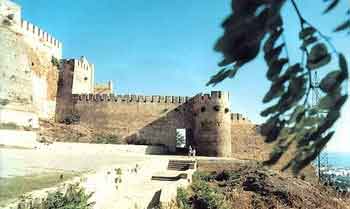.

The Gates of Alexander were a mythical barrier supposedly built by Alexander the Great in the Caucasus to keep the uncivilized barbarians of the north (usually associated with the Gog and Magog legend) from invading the land to the south. The gates were a popular subject in medieval travel literature, starting with the Alexander Romance in a version from perhaps the 6th century AD. The wall has been frequently identified with the Caspian Gates of Derbent, Russia (see below).
In the Alexander Romance, Alexander chases his enemies to a pass between two peaks in the Caucasus known as the "Breasts of the World". He decides to imprison the "unclean nations" of the north, which include Gog and Magog, behind a huge wall of steel or adamantine. With the aid of God, Alexander and his men close the narrow pass, keeping the uncivilized Gog and Magog from pillaging the peaceful southern lands. The nature of the pass is never very clear; some sources say it is a pass between mountains, while others say it is a pass between the peaks and the Caspian Sea.
The story appears in the Qur'an, Surat al-Kahf (The Cave) 83-98, where the great hero Dhul-Qarnayn ("The Two-horned One") constructs the gates to protect the innocent people at the feet of the mountains from Gog and Magog. That this story appeared in a fictional account before the Qur'an was written has caused some controversy among Islamic scholars, though some would argue that "Dhul-Qarnayn" is not supposed to be Alexander at all, but rather some earlier or later conqueror.
During the Middle Ages, the Gates of Alexander story was included in travel literature such as the Travels of Marco Polo and the Travels of Sir John Mandeville. The identities of the nations trapped behind the wall are not always consistent, however; Mandeville claims Gog and Magog are really the Ten Lost Tribes of Israel, who will emerge from their prison during the End Times and unite with their fellow Jews to attack the Christians. Polo speaks of Alexander's Iron Gates, but says the Comanians are the ones trapped behind it. He does mention Gog and Magog, however, locating them north of Cathay. Some scholars have taken this as an oblique and confused reference to the Great Wall of China, which he does not mention otherwise.
The Caspian Gates at Derbent
The Gates of Alexander are most commonly identified with the Caspian Gates of Derbent, Russia. The city was built around the world's only surviving Sassanid Persian fortress, which served as a strategic location protecting the empire from attacks by the Dagestanis. The historical Caspian Gates were not built until probably the reign of Khosrau I in the 6th century, long after Alexander's time, but they came to be credited to him in the passing centuries. The immense wall had a height of 29 feet (9 m) and a thickness of about 10 feet (3 m) when it was in use.
Although the current fortificactions date to well after Alexander's death, some scholars postulate that there might have been earlier fortifications built during the Achaemenid Persian Empire (the area has indeed been settled for at least 5000 years). If this is true, agents of Alexander's empire may have visited or even strengthened them after the Achaemenids were conquered, though Alexander personally never travelled that far north.
Links
Chapter 29 of the Travels of Sir John Mandeville, which includes the Gates of Alexander story
| Ancient Greece
Science, Technology , Medicine , Warfare, , Biographies , Life , Cities/Places/Maps , Arts , Literature , Philosophy ,Olympics, Mythology , History , Images Medieval Greece / Byzantine Empire Science, Technology, Arts, , Warfare , Literature, Biographies, Icons, History Modern Greece Cities, Islands, Regions, Fauna/Flora ,Biographies , History , Warfare, Science/Technology, Literature, Music , Arts , Film/Actors , Sport , Fashion --- |
Retrieved from "http://en.wikipedia.org/"
All text is available under the terms of the GNU Free Documentation License

